How do you describe your menstrual cycle? Predictable or erratic, heavy or light, painful or just inconvenient? I’m sure you can think of dozens of adjectives to describe your monthly cycle, and yours would be different than every other woman. Because just like every other parameter of health, there is no perfect way to have a period. Due to the diversity among female bodies, what is normal for one woman may be totally unusual for another. Rather than look at what’s normal, then, let’s discuss what it means to have a healthy menstrual cycle.
What a Healthy Menstrual Cycle Looks Like
Premenstrual Syndrome
Most women don’t feel their best in the days or week leading up to their period. Mild fatigue, irritability, appetite changes, and bloating are common period precursors for many women. While mild PMS symptoms do not warrant concern, severe symptoms may be a sign of an issue.

If, for example, your PMS symptoms are severe enough to cause you to miss work or school, it’s time to dig a little deeper. Debilitating cramps, uncontrollable mood swings, migraine headaches, and chronic fatigue are not normal. These are all manifestations of an imbalance between estrogen, progesterone, testosterone, and cortisol.
If you experience severe PMS, there are a few things you can do.
- Get adequate sleep. Just like every other body system, your reproductive system depends on sleep to function properly.
- Nourish your body. Nutrition is super important during your period, when your body needs a little extra boost of some key vitamins, like magnesium and B6.
- Engage in light exercise. No need to go crazy, but studies show that light exercise actually helps regulate your cycle.
- Find ways to relieve stress. I can’t emphasize this one enough. When you stress, your body produces more cortisol, which directly affects your progesterone levels and can totally mess with your cycle and exacerbate PMS symptoms.
Regularity
Most women’s menstrual cycles are between 25 and 35 days long. Wherever your cycle falls within that range, it should be relatively consistent from month to month. If it varies widely each month, you may be dealing with fluctuating hormone levels.

If you tend to skip periods or have excessively short or long cycles, it may be a sign of a hormonal imbalance or another health issue. Irregular cycles usually indicate that ovulation is not taking place, and this may be due to an underlying illness, such as thyroid disease, polycystic ovarian syndrome (PCOS), ovarian cysts, adrenal issues, etc.
Duration
The duration of your period should also be somewhat regular. Most women’s periods last from 4 to 7 days. In most cases, there’s no need to worry if your period is a couple of days longer or shorter than the average.
However, if you bleed for more than 7 days—especially if your flow is particularly heavy—or if you only experience spotting or light bleeding for less than 3 days, it may be time to consult your doctor.
Color
Period blood should be bright red in color. Red blood is a sign of good blood flow to the pelvic region. On the other hand, dark red or brown blood can indicate that blood is stagnating in the uterus. This may result from poor circulation or a hormonal imbalance.

One simple remedy for stagnant blood flow is castor oil packs. The heat from a castor oil pack increases blood flow and may improve oxygenation to target tissues.
Cervical Fluid
Throughout your cycle, you should experience changes in your cervical fluid. These changes indicate the fluctuation of hormones and are a sign of a healthy menstrual cycle.
- Leading up to and right after your period, estrogen levels are low, and you may feel more dry as cervical fluid decreases.
- As your body approaches ovulation, estrogen levels rise, and your cervical fluid should be wet and may appear slightly opaque.
- During ovulation, cervical fluid is more slippery and even a bit stretchy.
- Immediately after ovulation occurs, progesterone levels increase causing cervical fluid to become more sticky and decrease.
Keeping Comfortable During Your Cycle

Throughout your menstrual cycle, you’ll experience a range of fluids. My favorite way to stay comfortable—and free from leakage—throughout my cycle is with Thinx period underwear. Thinx feel like regular underwear, and I trust me, I don’t miss using bulky pads or uncomfortable tampons! To learn more, check out this post about 8 Ways Thinx Makes Your Period More Bearable.
But don’t take my word for it, get $10 off your first pair of Thinx with their 60-day satisfaction guarantee.












